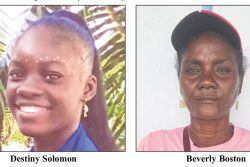Over the next three years, communities in regions One and Nine will benefit from an India-UN Development Partnership Fund (UNDPF) project geared towards a 10 per cent reduction of adolescent pregnancy within indigenous communities.
The India-UNDPF is a dedicated facility within the United Nations Fund for South-South Cooperation established in 2017. It supports Southern-owned and led, demand-driven, and transformational sustainable development projects across the developing world.
The US$559,496 project was launched at the Sophia Exhibition Centre yesterday and will be implemented by the United Nations Population Fund (UNFPA) in collaboration with the Ministry of Public Health and the Guyana Responsible Parenthood Association (GRPA) from July this year to June 2022.
Statistics compiled by the UNFPA and CARICOM in 2014 show that Guyana has the highest rate of adolescent pregnancy in the English-speaking Caribbean, while the 2018 PAHO/WHO Situation Analysis of Adolescent Pregnancy in Guyana estimates adolescent fertility rate at 74 births per 1,000 girls aged 15-19, which is well above the Caribbean average of 60.2.
Additionally, the 2017 UNICEF Study on Indigenous Women and Children in Guyana found that regions One, Seven and Nine have unacceptably high rates of adolescent pregnancy with indigenous girls specifically experiencing the highest rates among all ethnic groups.
The India-UNDPF project aims to improve the availability of, and access to quality sexual and reproductive health information and services, including commodities, for adolescents.
According to Adler Bynoe, UNFPA Liaison Officer for Guyana, the project also aims to empower communities, parents and adolescents to prevent adolescent pregnancy in regions One and Nine.
Specific goals include a 10 per cent reduction in adolescent pregnancy in these two regions by March 2022 so as to assist in Guyana’s efforts to realise three of the Sustainable Development Goals. These are Goal 3 – Good Health and Well-Being, Goal 5 – Gender Equality, and Goal 10 – Reduced Inequalities.
The project will be implemented in three phases and in all five sub-regions of Region Nine and the three sub-regions of Region One, simultaneously.
“The programme will be implemented in an inclusive way with all relevant stakeholders such as adolescents, young people, regional village/community leaders participating in the implementation which will also be aligned with existing services to ensure sustainability,” Bynoe explained to Stabroek News.
The first phase, which is expected to last six months, will realise a formative assessment and consensus building and will include meetings with key stakeholders in Georgetown, Central Lethem (Region Nine) and Mabaruma (Region One) and in each sub-region.
“During this phase, all the preparations for trainings and the roll-out of the programme will be in place. Definition of the programme targets will take place as well as any adjustments that might be needed to the approach. In addition, during this phase, UNFPA will work with the implementing partners in establishing the necessary arrangements inclusive of micro-assessments and annual work programmes. This phase will also include the recruitment of the Sexual and Reproductive Health Officer and the Monitoring and Evaluation Officer,” Bynoe said, while adding that Phase Two will be the actual implementation of the project over a 27-month period.
It will include training of personnel within each sub-region, monitoring of the project, integration with existing services for sustainability, and documentation of processes and results. The final two months – Phase Three – will see a consolidation and preparation for exit.
“The Ministry of Public Health will ensure the requisite capacity is in place for continued work of a high quality,” Bynoe emphasised.
Speaking at the launch, Minister of Public Health Volda Lawrence said that the statistical realities of adolescent pregnancy in Guyana means that the project is “critical.”
She explained that factors contributing to this high pregnancy rate include lack of access to contraceptives and comprehensive sexual education, as well as risky sexual behaviours and early sex.
The minister further noted that one factor often overlooked is cultural differences which must be considered in the project implementation.
“We will find as we move from one tribe to the other that cultural differences stand out,” she advised.
According to Lawrence, following the situational analysis, the ministry recognised the enormous challenges and sought the support of local and international partners rather than filing the report away.
Following this outreach, the UNFPA in early 2018 hired a consultant to support the ministry’s Adolescent Health Unit in developing a project proposal which was later submitted to and subsequently approved by the India-UNDPF.
Government, the minister said, made a commitment to align the Adolescent Health Unit with the strategic action outlined in the Global Strategy for Women’s, Children and Adolescent Health 2016-2030, which has resulted in this project.
She observed that it will still be the responsibility of the government to make similar interventions in Region Seven, which was also identified in the strategic report.









